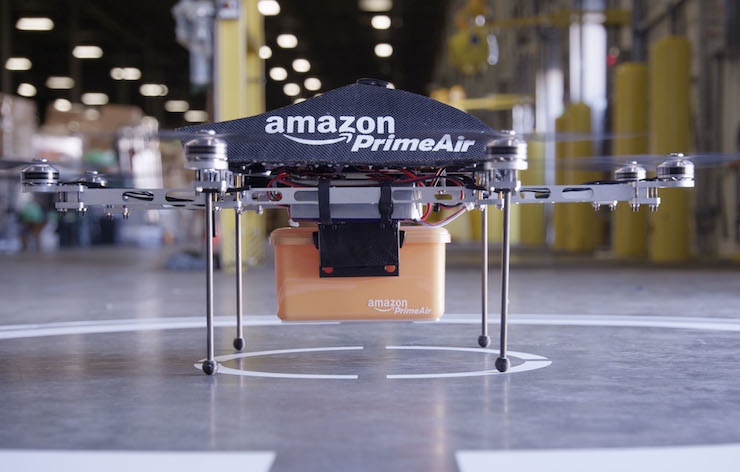Amazon Launches Drone Delivery Trial in Arizona

As the holiday shipping season gears up, residents of a small town in Arizona will have quicker access to some of their Amazon purchases. Tolleson, AZ, is about 12 miles west of Phoenix in an area known as the West Valley. The town covers just under 6 square miles and is home to an Amazon Fulfillment Center. This fulfillment center establishes Tolleson as a logistically ideal community for Amazon to trial its latest drone delivery program, a program the company hopes to expand to further communities in the United States and Europe in the near future.
It has been more than a decade since Amazon’s founder and former CEO, Jeff Bezos, announced his vision of enabling drone-based deliveries for customers. However, as the largest e-commerce company in the world, Amazon has faced a considerable number of hurdles conquering America’s low airspace with delivery drones. For smaller businesses like restaurants or cafes using drones to deliver meals, or pharmacies using drones to deliver medications, drone logistics are simpler. These business models work with smaller inventories being delivered within a smaller radius. Amazon’s vast inventory and customer range, however, have caused the company to struggle with meeting technology and regulatory demands.
There have been a few select Amazon drone delivery trials, but the one set to commence in Arizona’s West Valley should be the most comprehensive to date. In November 2024, Amazon announced that it had received approval from the Federal Aviation Administration (FAA) to begin deploying its newest drone, the MK30, out of the Tolleson warehouse. Included in this FAA waiver is the ability to fly drones Beyond Visual Line of Sight (BVLOS). With BVLOS capabilities, Amazon will be able to safely deliver goods over a wider area, making the program logistically feasible.
The MK30 is the centerpiece of the trial. After years of experimental prototypes, Amazon said it spent approximately 18 months redeveloping its drone platforms to create this new and improved design. The Vertical Take-Off and Landing (VTOL) drone is about 5 feet in diameter and weighs around 80 lbs. Once airborne, the drone transitions to horizontal flight. This allows the drone to operate in more crowded environments while maintaining optimal flight efficiency. This efficiency means the MK30 can fly up to 2 times longer than its predecessor. In a press release, Amazon states, “The drone uses industry-leading ‘sense and avoid’ technology that allows them to detect and avoid obstacles including people, pets, and property. Innovative safety-critical features will allow this drone to deliver packages to customers with smaller backyards and in more densely populated suburban areas.”
Customers in the West Valley can choose from 50,000 items on Amazon eligible for drone delivery. The total weight of the items selected must be less than 5 lbs and fit into a specially designed cardboard box about the size of a shoebox. An Amazon employee will load the package into the drone, which will deliver it to the customer within an hour or less. The drone flies below the FAA’s 400-foot limit, then descends to about 12 feet to drop the package on a customer’s property. Drone delivery will be available 7 days a week between the hours of 7 am and 10 pm, for an additional fee of $9.99 for Prime members and $14.99 for non-members. The MK30 can even operate in light rain, widening delivery options.
When developing the MK30 drone, Amazon took into consideration the concerns of its customers. The drones are fully autonomous but will always have a mission operator overseeing deliveries. Customers do not need to be present to receive deliveries, and the drone’s sense and avoid technology ensures that packages will not be dropped on anything living or inanimate in a way that could cause damage. One of the most critical adjustments Amazon made to meet customers’ concerns is to reduce drone noise pollution. “The MK30 is quieter than previous models,” the press release explains. “Prime Air’s Flight Science team custom-designed the propellers to reduce the MK30’s perceived noise by almost half. Even as the drone is descending, its sound is still quieter than the range of sounds you’ll generally hear in a neighborhood.”
With low wind conditions, minimal rainy days, and the proximity of the Tolleson fulfillment center, the West Valley is poised to be Amazon’s definitive drone delivery testing site. The MK30 trial will hopefully lead to a system that would allow drones to make regular deliveries in more congested regions like Manhattan or Los Angeles. “With the MK30,” the company goes on to say, “Amazon is making faster and safer drone delivery possible. Our vision is to develop drones that can fly thousands of times and deliver millions of packages annually.”
|